- Why is Flammability Testing Important?
- What is Flash Point?
- What is Autoignition Temperature?
- Difference between Flash Point and Autoignition Temperature Testing
- Additional Available Tests and Consulting Options
Why is Flammability Testing Important?
The all too frequent occurrence of fires and explosions in the process industries that use flammable materials is typically the result of a variety of factors including a flammable or explosive mixture being present in the vapor space, lack of knowledge of the properties of the chemical’s inherent safety implications, and/or inadequate safety procedures.
In order to minimize the risk of fire or explosion, it is important to evaluate the flammability characteristics of the material to understand key characteristics such as the lower flammability limit, upper flammability limit, limiting oxygen concentration and deflagration index. Simply put, these are defined as:
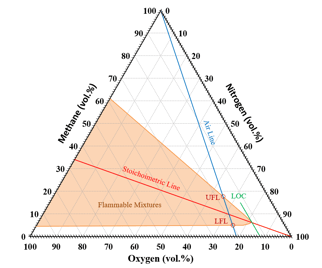
- Lower Flammability Limit (LFL) - the lowest concentration at which a mixture of flammable vapor or gas and air is flammable.
- Upper Flammability Limit (UFL) - the highest concentration at which a mixture of flammable vapor or gas and air is flammable.
- Limiting Oxygen Concentration (LOC) - the minimum concentration of oxygen required to produce a flammable event when mixed with a flammable vapor or gas in any concentration.
- Deflagration Index (KG) - the volume-normalized maximum rate of pressure rise for a flammable mixture in air.
A variety of different flammability tests can be performed to allow for determination of these characteristics, and the understanding of these conditions is essential when implementing proper safety practices.
When conducting flammability testing, it is important that clients communicate what data is being sought so that testing can be properly designed in order to determine the necessary flammability property of a chemical mixture.
A good flammability testing regime will take into consideration the many different variables that affect the flammability of a specific chemical: oxidizing environment, temperature, pressure, ignition energy, size and geometry of the vessel, gas composition, etc. There are a variety of pressure vessels varying in size and geometry to use for flammability testing purposes dependent on the particular need. The choice (spherical, cylindrical, large, small, glass, steel, etc.) depends on the particular test design. A well-defined ignition source is also necessary, as is a robust data acquisition system for monitoring pressure and temperature.
Accounting for these variables can result in test data that are much more applicable to your specific process than information taken from literature. Experts are happy to have a discussion with you about your flammable hazard concerns and work with you on designing tests that get you the information you need. The goal is to provide you with specific data that corresponds to your process - not just meaningless data.
There are a variety of pressure vessels varying in size and geometry to use for flammability testing purposes dependent on the particular need. The choice (spherical, cylindrical, large, small, glass, steel, etc.) depends on the particular test design. A well-defined ignition source is also necessary, as is a good data acquisition system for monitoring pressure and temperature.
Data acquired from testing can be used to implement proper safety procedures and designs to help minimize the chance of an explosive event in your process.
What is Flash Point?
The flash point is the minimum temperature at which vapors given off by a liquid pool or solid layer form an ignitable mixture with air. Flash point testing is used to assess the relative flash-fire hazards of handling and processing liquid and solid materials. Results from this test, in conjunction with vapor pressure or boiling point tests, will help characterize a liquid as either being flammable or combustible based on the criteria of organizations such as the NFPA, EPA, OSHA, or UN. Characterization of liquids using the flash point test will provide information on the proper packaging and shipping group for transportation purposes, in addition to storage and handling requirements.
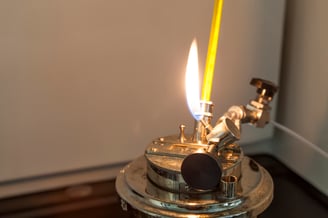 Depending on material properties, testing can be performed to determine the closed or open cup flash point using one of these listed standards:
Depending on material properties, testing can be performed to determine the closed or open cup flash point using one of these listed standards:
ASTM D1310 "Standard Test Method for Flash Point and Fire Point of Liquids by Tag Open-Cup Apparatus"
ASTM D3278 “Standard Test Methods for Flash Point of Liquids by Small Scale Closed-Cup Apparatus”
ASTM D3828 “Standard Test Methods for Flash Point by Small Scale Closed Cup Tester”
ASTM D56 “Standard Test Method for Flash Point by Tag Closed Cup Tester”
ASTM D92 “Standard Test Method for Flash and Fire Points by Cleveland Open Cup Tester”
ASTM D93 “Standard Test Methods for Flash Point by Pensky-Martens Closed Cup Tester”
What is Autoignition Temperature (AIT)?
The autoignition temperature (AIT) is a flammable property defined as the lowest temperature environment at which a gas or vapor will spontaneously ignite without a distinct/localized ignition source such as a spark or flame. It is helpful to know the autoignition temperature if chemicals are being handled or processed under elevated temperature and/or pressure conditions. This flammability property is dependent on numerous factors including pressure, temperature, oxidizing atmosphere, vessel volume, and fuel/air concentration among others. Therefore, it is important to characterize the autoignition hazard at as close to your process conditions as possible.
Depending on material properties, testing can be performed to determine the autoignition temperature using one of these listed standards:
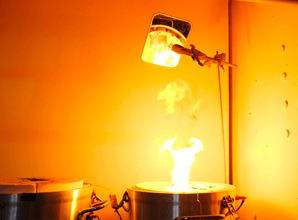
ASTM E659 “Standard Test Method for Autoignition Temperature of Liquid Chemicals”
ASTM D1929 "Standard Test Method for Determining Ignition Temperature of Plastics"
Difference between Flash Point and Autoignition Temperature Testing
A certain concentration of vapor in the air is necessary to sustain combustion, and that concentration is different for each flammable liquid. The flash point of a flammable liquid is the lowest temperature at which there will be enough flammable vapor to ignite when an ignition source such as a flame is applied into the vapor space. Unlike flash points, the autoignition temperature does not use an ignition source. In other words, the autoignition temperature is the lowest temperature at which a volatile material will be vaporized into a gas which ignites without the help of any external flame or ignition source, but instead, uses heat to commence the combustion reaction. As a result, the autoignition temperature is higher than the flash point temperature.
Closed cup flash point testing is conducted inside a sealed vessel where the ignition source is introduced periodically into the vapor space of the vessel. As a result, the substance is minimally exposed to the elements outside of the vessel, which can have an interfering effect on the results of the test. This, in turn, also leads to lower flash points compared to open cup flash point methods, because the heat and flammable vapors are trapped inside. Because it is lower, the flash point is also safer for widespread use, and as such is more generally accepted.
Autoignition temperature tests are performed by placing the substance in a half-liter vessel inside a temperature-controlled oven. The temperature of the vessel is then adjusted until the lowest temperature at which the material spontaneously ignites in air is determined.
To help assess your risk exposure by characterizing the flammability potential of your combustible gas, vapor or solids, the following is a list of the most common tests, in addition to flash point and AIT, that are performed for flammability hazard characterization. Specialized testing can be also performed to more closely match your process conditions and thereby better gauge your risk.
Additional Available Tests and Consulting Options:
- Flammability Limits (LFL, UFL) - The flammability limits for a fuel-oxidizer mixture comprise a lower flammable limit (LFL) and an upper flammable limit (UFL). Flame propagation is not supported if the fuel concentration is either below the LFL or above the UFL in an oxidizing atmosphere. However, concentrations of mixtures in between these two limits will result in the formation of a flammable atmosphere, and a fire or explosion could occur. The flammability limits of a fuel-oxidizer are similar to the autoignition temperature in that they depend on numerous conditions: temperature, pressure, ignition source, vessel size and geometry, the direction of flame propagation, and mixture composition. Caution must be taken in the determination of the flammable limits since there are numerous factors that affect these measurements. Therefore, it is crucial to determine these limits as closely as possible to actual process conditions.
Determination of flammability limits provides an understanding of the possible safety hazards present in a process, and also provides guidance on how to safely operate a process outside of the flammable region. Often it is not practical to operate large-scale processes in an entirely inert environment, so knowledge of the flammability limits provides some flexibility in process operations.
Relevant standards FAI currently conforms to:
ASTM E681 “Standard Test Method for Concentration Limits of Flammability of Chemicals (Vapors and Gases)"
ASTM E918 “Standard Practice for Determining Limits of Flammability of Chemicals at Elevated Temperature and Pressure"
- Flash and Spontaneous Ignition Temperature of Plastics - Processing of plastics at elevated temperature could produce a flammability hazard as a result of the formation of flammable vapors. There are two possible risks associated with processing plastics at elevated temperature: Flash Ignition Temperature and Spontaneous Ignition Temperature. The flash ignition temperature is the minimum environment temperature at which there is a sufficient evolution of vapors from the decomposing plastic to mix with air and from an ignitable mixture; when exposed to a localized ignition source. The spontaneous ignition temperature on the other hand is the minimum environment temperature at which the evolved vapors from the decomposition of the plastic auto-ignites.
Relevant standards FAI currently conforms to:
ASTM D1929 “Standard Test Method for Determining Ignition Temperature of Plastics"
ISO 871 “Plastics – Determination of ignition temperature using a hot-air furnace”
- Sustained Burning/Combustibility (Fire Point) - Sustained burning (sometimes referred to as sustained combustibility or fire point) is the lowest temperature at which the vapors produced above the liquid surface will continue to burn once ignited – not just create a flash fire. The result from this test could be used in the evaluation of a fire risk assessment because this test method measures the tendency of the specimen to support sustained combustion. The fire point temperature is typically greater than the flash point temperature.
Relevant standards FAI currently conforms to:
ASTM D4206 “Standard Test Method for Sustained Burning of Liquid Mixtures Using the Small Scale Open-Cup Apparatus”
ASTM D92 “Standard Test Method for Flash and Fire Points by Cleveland Open Cup Tester”
Test L.2 “Sustained Combustibility Test”
- Lower Temperature Limit of Flammability (LTL) – The temperature limit of flammability is the minimum temperature at which vapors in equilibrium with a liquid will be sufficiently concentrated to form flammable mixtures in an oxidizing atmosphere at atmospheric pressure. In theory, the lower temperature limit of flammability and the flash point should be the same; however, this is not always the case and is a result of the variations in the test apparatus as well as the test methodology.
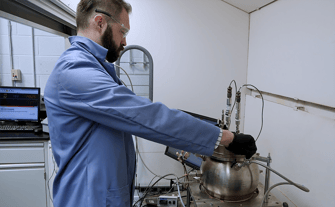 It is imperative to fully characterize the flammability hazards of chemicals because the use of the flash point by itself may not always be sufficient in providing proper safety precautions to avoid flammable temperatures when assessing the hazards of flammable liquids. Even the use of a safety margin with the flash point value may not always be adequate to protect a given system. LTFL testing allows for accurate assessment of the temperature at which there is sufficient vapor for flame propagation, and enables design of the correct safety margin.
It is imperative to fully characterize the flammability hazards of chemicals because the use of the flash point by itself may not always be sufficient in providing proper safety precautions to avoid flammable temperatures when assessing the hazards of flammable liquids. Even the use of a safety margin with the flash point value may not always be adequate to protect a given system. LTFL testing allows for accurate assessment of the temperature at which there is sufficient vapor for flame propagation, and enables design of the correct safety margin.
Relevant standards FAI currently conforms to:
ASTM E1232 “Standard Test Method for Temperature Limit of Flammability of Chemicals”
For more information about a comparison between the flash point and the LTL, please see the article “Evaluating the flammability hazard of liquid vapors” in our Winter 2012 Process Safety newsletter.
- Limiting Oxygen Concentration (LOC) - The limiting oxygen concentration (LOC) is the minimum amount of oxygen needed to support flame propagation. The LOC can be used to help determine proper inerting and purging procedures to keep a process material outside of the flammable region. The LOC is dependent on test conditions such as temperature, pressure and inert material used. The data could also be used to help take a vessel out-of-service or commissioning a vessel to be brought into service.
Relevant standards FAI currently conforms to:
ASTM E2079 “Standard Test Methods for Limiting Oxygen (Oxidant) Concentration in Gases and Vapors”
EN 14756 “Determination of the limiting oxygen concentration (LOC) for flammable gases and vapours”.
- Minimum Ignition Energy (MIE) - The minimum ignition energy (MIE) is the minimum amount of energy needed to ignite a flammable mixture. The MIE helps to give an understanding on the ease of ignition for a gas mixture. The MIE is a function of test conditions including temperature, pressure and mixture composition. Under certain conditions, the MIE may be high enough where elimination of the ignition source from process operations may be a sufficient means of explosion prevention. Another parameter associated with MIE is the ignition quenching distance. This is the maximum distance at which a flame will not be able to propagate upon ignition.
Relevant standard FAI currently conforms to:
ASTM E582 “Standard Test Method for Minimum Ignition Energy and Quenching Distance in Gaseous Mixtures”.
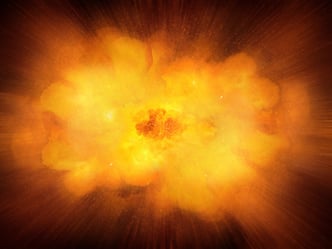
- Explosion Severity (PMAX , KG) - Under certain circumstances, it may be necessary to operate a process inside of the flammable region, thereby, presenting the risk of a fire and/or explosion hazard. At this point, explosion protection equipment and controls are needed to operate this process safely. Performing explosion severity tests will help determine the extent of protection needed in the process. This testing will determine the maximum explosion overpressure (PMAX) generated during an ignition event of the flammable mixture as well as the deflagration index (KG) which is the maximum rate of pressure rise normalized to the vessel volume. These parameters can be used to help pressure rate a vessel for containment purposes or be used to design an explosion relief system.
Relevant standards FAI currently conforms to:
EN 15967 “Determination of the maximum explosion pressure and maximum rate of pressure rise of gases and vapours”
- Heat of Combustion (HOC) - The heat of combustion for a chemical is the heat released when that chemical undergoes complete combustion with oxygen at standard conditions. The heat of combustion can be measured experimentally through a few different setups. One such setup is an Oxygen Bomb Calorimeter which can determine the Higher Heating Value (HHV) heat of combustion for solid or liquid samples. The HOC is important to determine the energy content of a chemical which could be used as source for energy and can be used to determine the thermal efficiency of equipment used to produce power or heat. Please see our "Heat of Combustion" article in the Winter 2012 Process Safety Newsletter for additional information.
Relevant standard that FAI currently conforms to:
ASTM D240: "Standard Test Method for Heat of Combustion of Liquid Hydrocarbon Fuels by Bomb Calorimeter”
Other Testing - At FAI, we have an extensive knowledge regarding the design and development of specialized tests and test apparatuses. We continue to expand our testing capabilities and push the limits for testing conditions. As a result, we are able to offer solutions for scenarios not typically quantified by standard test methods.
.jpg?width=406&name=628950000(1).jpg) Some of the test options that we provide include:
Some of the test options that we provide include:
- Elevated temperature testing
- Elevated pressure testing
- Ozone testing
- Various volumes for test variations (1L, 5L, 20L, etc)
Consulting
- Desktop and/or on-site assessments per NFPA or OSHA for handing, processing or storing of flammable materials
- Flammable hazard calculations:
- Estimating flammable properties (LFL, UFL, AIT, etc.) or explosion severity
- Modeling flammable gas distribution and hazards during an upset scenario
- Process Hazard Analysis (PHA) assistance
For more information regarding your specific testing needs and our industrial safety management services, please contact: info@fauske.com, 630-323-8750

